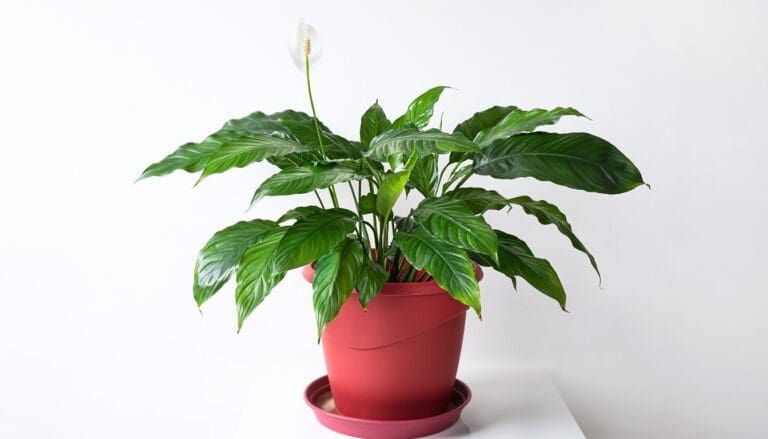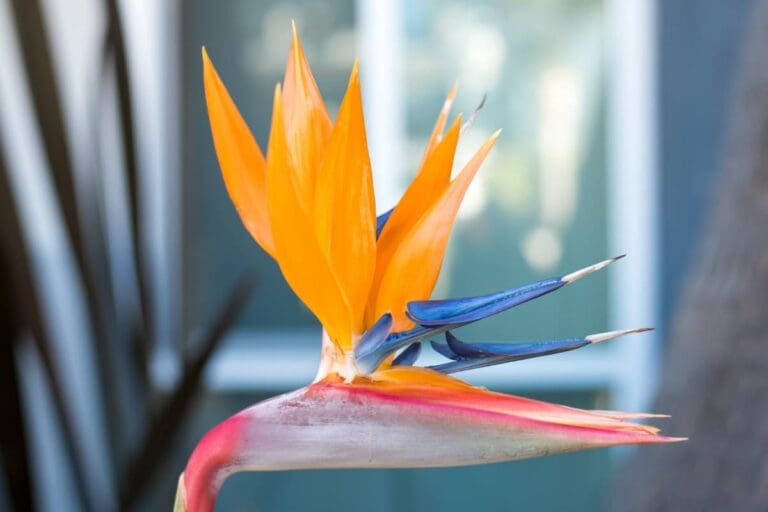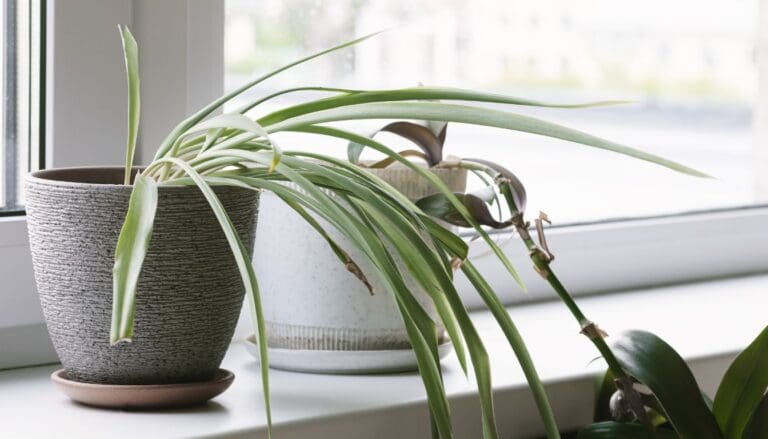7 Reasons Why Your Snake Plant Is Turning Brown
The snake plant species are very sturdy when it comes to temperature resistance and atmospheric conditions. But not everyone is successful with the plant. Some of our readers compliant about brown tips and brown spots on their rubber plant. But why do rubber plant leaves turn brown? Let’s find out.
Overfertilization, inadequate watering, direct sunlight, and pest infestation are common causes of brown leaves in the snake plant. While the brown tips indicate insufficient watering and too much light, brown spots can result from overwatering and pest infestation.
Though being a tough warrior, there could always be particular stress or an issue the plant could be facing, and we need to figure this out.
Plants send specific signals or symptoms for us to understand, and we must choose to nurture the plant.
In the case of the snake plants, the browning of the plant could be for various reasons. However, we will need to smartly identify the issue first and then proceed with the nurture.
Do not worry. We will simplify your life as well as your plant’s life.
Let us get right into it.
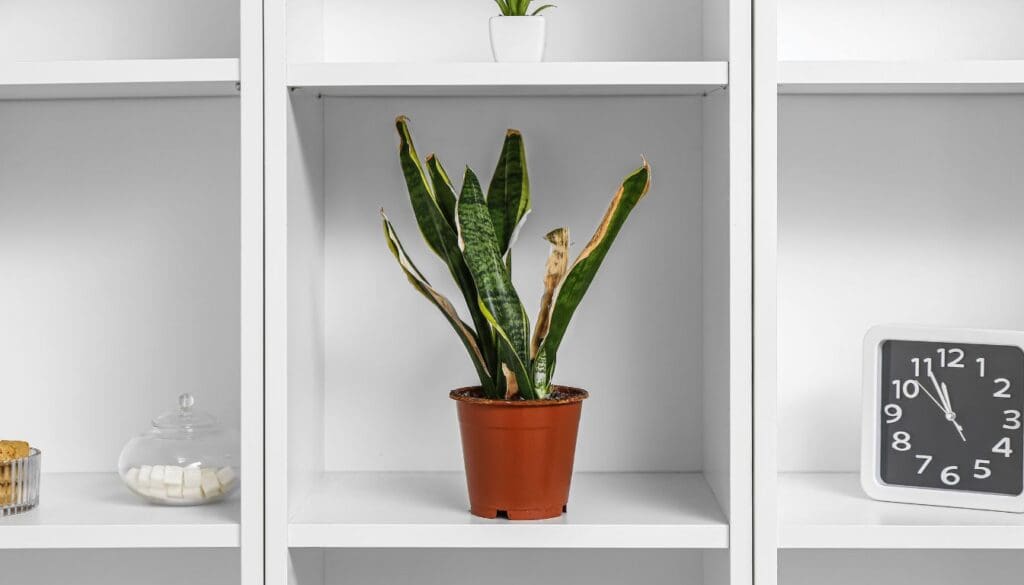
Please note: Simplify Plants is reader-supported. Some links in the post are affiliate links and I get a commission from purchases made through links in the post.
Identifying the browning
To correctly understand the plant’s symptoms, we need to decode the issue step by step.
The first rule here is to never try and solve all the issues at once because the plant is already going through stress, and trying to fix all the issues at once might kill the plant.
Thus, we always try and fix a single issue first.
Now, let us take a look at our Snake plant. What do you see? Where are the brown spots?
The browning of the leaves of the snake plant can be of two types:
- Browning at the edges or the tip of the leaves
- Brown spots on the leaves
Both scenarios are different and are caused by different reasons altogether.
In this guide, we will decipher the signals that your Snake plant is sending. Let us take a look at each topic.
Snake plant has brown tips
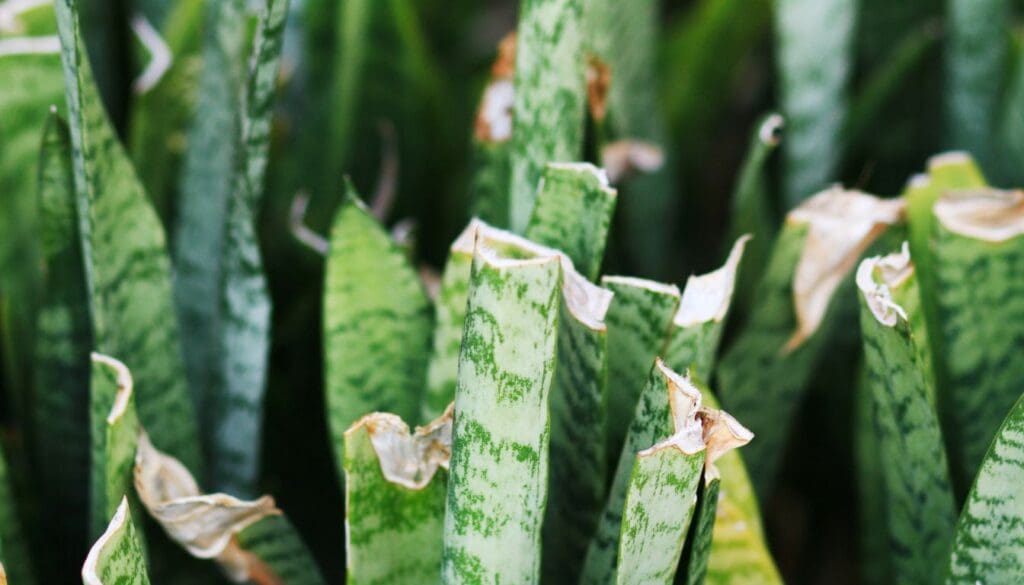
The Snake plant is gaining popularity amongst plant owners and the new hobbyist because of its sturdiness.
This beautiful plant can thrive in extreme atmospheric conditions; however, it is a living thing and is bound to go through rough patches.
Many reasons can cause brown tips on the snake plants. Let us go through a few reasons, and we will also guide you on how to avoid such situations.
The reason behind the brown tips include:
- Direct Sunlight
- Overfertilization of the Snake plant
- The Pest Situation
- Watering Problems
- Stress caused by the Cold weather/ Cool draft
- Changes in the environment
- The type of Water
The above might be some common reasons behind the browning of the tips of your snake plant. However, the list is not exhaustive for the situation.
It could very well be that the plant is showing the symptom for some different reason together, but the above is the most common reason.
Now, we will take each topic in detail to understand how the above factors affect the Snake plant.
Direct Sunlight

The Snake plant is known to be drought-tolerant, but it is not invincible. They are also known to be grown outside in the garden.
If you are thinking of moving your indoor Snake plant to the garden directly, then it is a bad choice.
It is not that the snake plant will not thrive in the direct sun, but the snake plant will need to adapt to the situation first.
Someone who stays in Siberia cannot survive in the tropical areas instantly. He/she will need to adapt to the heat and will need to adjust.
Similarly, your Snake plant can be moved to the garden or in the direct sun, but gradually.
Never move a plant from one extreme to another because this causes stunted growth, and stunted growth is not suitable for a plant.
If your snake plant is kept mostly indoors and does not receive enough direct sunlight, keeping it in direct sunlight will give symptoms like brown tips.
Brown tips caused by excessive sunlight is the result of leaf burn.
For this, we will need to make sure that the plant is taken care of. What we can do is pruning!
Check for the damage and the number of brown tips. We can either prune the tips of the leaves or the whole leaf if the damage is much.
Assess the situation and then make a move. I know it is tough to prune, and one might find it hard, but the damaged leaves won’t do any good to the plant.
The plant will grow healthy leaves if taken good care of.
So, take a clipper/pruner and apply some rubbing alcohol to the pruner before we begin our pruning.
Once the plant is pruned, please give it a gentle watering and take good care of the plant.
If you plan to provide direct sunlight, then start with an hour of direct sunlight daily and slowly increase the hours.
That will help your Snake plant to adapt to the situation and will thrive in direct sunlight.
Also read: How much light do snake plant need?
Overfertilization of the Snake plant

Fertilization is crucial for any plant because fertilizer helps the plant with the desired nutrients that the plant needs to grow efficiently.
The Snake plant in the same nature requires fertilization.
Snake plant has two prevalent issues that are the overfertilization and overwatering.
New hobbyists often face these two situations because of minute neglect. You need not worry!
The mother-in-law’s tongue does not complain about excessive feed. How lovely can it be? No complaints and no demands!
Some users fertilize their snake plant only once or twice a year and continue to do so in the following year.
The snake plant can be fertilized up to two-three times in the growing season only. When it comes to fall, we reduce the feed by 70%.
During the winter, which is the dormant period for the snake plant, we do not fertilize the plant.
Also, make a note here, the snake plant is provided with a very dilute solution of a balanced 10:10:10 or a 20:20:20 fertilizer.
If the snake plant has been overfertilized, they will show signs like brown tips and the plant wilting. It can also lead to the drooping leaves and shedding of the leaves.
If the situation is neglected further, the plant might also give up on you. Hence, always be careful with the feed.
Provide a very dilute feed once a month during the growing season only.
How can we correct the overfertilization?
Take the plant and place it in running water and flush the excess fertilizer. Follow this process 3-4 times to remove the excess fertilizer.
If the situation has worsened, then we can repot the plant in a different pot.
Once the excess nutrient is removed, do not fertilize the plant for at least a month. Take care of the watering situation, and the plant should be healthy again.
Also read: Do snake plant need fertilization?(How much and how often)
The Pest Situation

Though being robust to survive in extreme conditions, snake plants are prone to be attacked by spider mites, mealybugs, and aphids.
If overwatered, the snake plant will develop a root rot situation, and the root rot invites pests. It could also be that the pests were transferred from another infected plant.
Whenever we see the brown tips, it is always good to carefully examine the plant and check bugs.
Snake plants develop brown tips if they have been infested.
To avoid this situation, we have been accustomed to the word Quarantine in this pandemic, and we will do the same with our snake plant. Isolate the plant from the others.
Isolation will help prevent the spread from one infected plant to another.
To cure the situation, we have two options.
- Go all organic
- Use of pesticides
If we choose to go all organic, we can use a neem oil solution and mix it with water. Then spray this mixture on your Snake plant.
Follow this process for about 14 days to kill the eggs if they have been laid on the Snake plant.
Mixing the neem oil solution in lukewarm water will prove to benefit.
We can also opt for the use of pesticides that are available in the market. However, if we choose this option, please do follow the instruction.
Never add extra pesticide to the plant than the amount prescribed because that can harm the plant even more.
The plant is already in stress and hence will develop the brown tips. Once they are relieved, the plant will grow as healthy as it was before.
Watering Problems

Now, we move towards the most common issue faced by many plant owners. Often, less water can cause issues, and it is the same as overwatering the plant.
In this watering problem, we will take a glance at Underwatering your Snake plant.
Underwatering Problems
Snake plants need to be watered when the soil is completely dried out. As this plant is a succulent, they store water on the leaves.
Too much neglect can also be harmful to the plant. Though it can tolerate drought conditions, leaving the snake plant dry for too long can show signs of brown tips.
It can also be a cause for watering without a schedule.
No schedule means that the plant was left dry for too long, and if tried to be fixed by adding a little extra water then required, the plant will develop brown tips.
To avoid the underwatering problems, we can follow a watering regime to not miss out on the watering. We can also attach a note to the plant for a reminder.
The best way is to feel the soil only when the soil feels completely dry, water the snake plant.
By following this, we can avoid underwatering problems.
Stress caused by the Cold weather
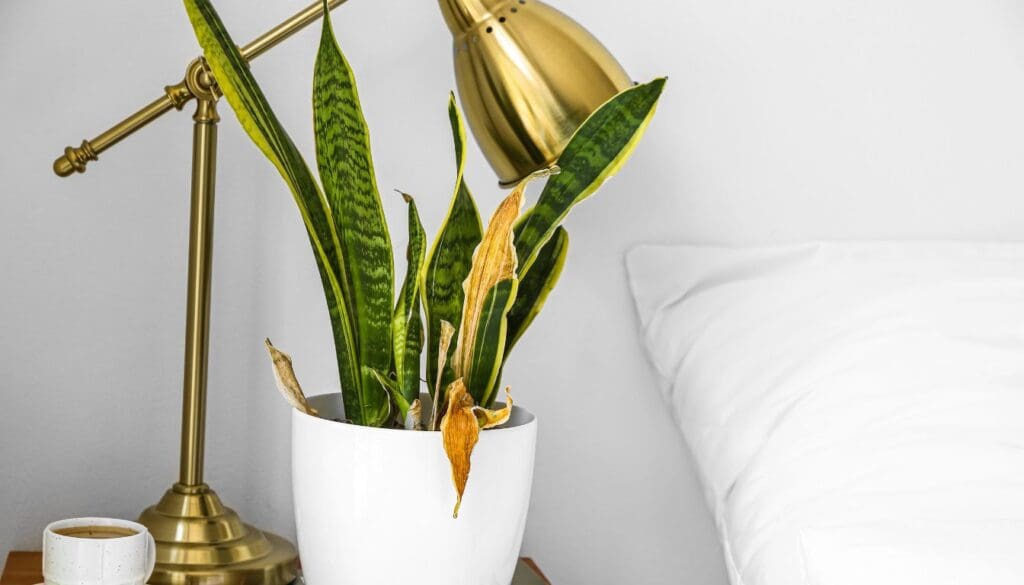
Snake plants go all dormant during the winter and can tolerate temperature up to 50°F (10°C). We need to make sure that the plant does not go below this temperature.
For indoor plants, we need to check the position of the plant. If the plant is kept in a southern window, then the cold draft will wilt the plant.
We will see signs of brown tips because of the cold draft.
Also, keep the snake plant away from the radiators so that it is not affected. The draft from the radiators is not suitable for the plant.
During the winter, maintaining humidity is a must. The snake plant, as said, does not complain, and neither does it require high humidity.
Snake plants prefer humidity between 40-50%. Use a humidifier to maintain the humidity level.
Changes in the environment
What do changes in the environment stand for in the case of Snake plants?
Snake plants can be grown indoors as well as in the garden. They thrive in extreme conditions.
However, never try to move the plant from one extreme to another.
What we mean by the above statement is that if the snake plant is kept indoors, then provide necessary conditions gradually to keep the plant outside in the garden and vice-versa.
Snake plants or any other plant will develop stress in such conditions, which will result in stunted growth.
If we want to keep the snake plant outside from indoor, then provide direct sunlight daily for a few hours. Follow this process for a few days and then slowly increase the timing.
Following this, the plant will adapt to the new changes in the environment, and there will be no symptoms.
The type of Water

In certain areas, the available water has an excess of chlorine dissolved in it. This excess chlorine is harmful to the Snake plant.
The snake plant will develop brown tips if the water has an excessive amount of chlorine dissolved.
How to avoid the situation?
To avoid this situation, take normal tap water and boil the water to remove the excess amount of chlorine dissolved.
Leave the water to cool down and use this water to water the snake plant.
Though the amount of chlorine is for human safety, some plants can react to it.
The most crucial point to consider here is to cool down the water before watering the plant.
Snake plant has brown spots
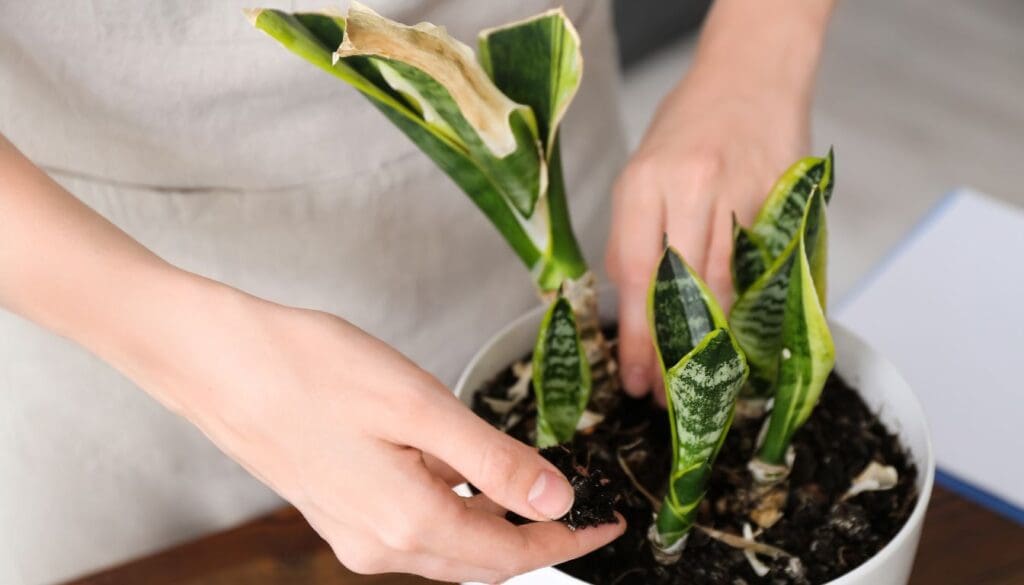
All the above that we saw was the reason behind the brown tips. However, brown spots are a bit different than the brown tips.
There are some reasons behind the brown spots on the leaves, and to summarize, we will look into:
- Overwatering situation
- Pest Condition
Let us understand each of them.
Overwatering Situation
The snake plant gets brown tips because of underwatering. However, overwatering causes the snake plant to develop brown spots on the leaves.
Overwatering is one common issue for this succulent. As they are succulent, they need significantly less water and need to be watered when the soil is completely dry.
If the plant is overwatered, we will see that the Snake plant will start wilting and have droopy leaves.
The overwatering also causes the snake plant to develop brown spots on the leaves, and the leaves are changing its color to yellow.
The overwatering situation has to be taken care of immediately and without fail as it can easily kill the plant.
The brown spots on the leaves are also known as leaf blight or edema.
If the situation is neglected further, the plant will develop a root rot, which can get even more difficult to handle, and we do not want a root rot.
How to avoid the situation?
To avoid this situation:
- Make a watering regime.
- Always feel the soil before watering the plant. If the soil feels wet, then do not water the plant. Wait for the soil to dry out completely.
- Check for the drainage holes, and if the holes are blocked, please clean them.
- Never allow the plant to stand on still water.
- If required, repot the plant.
Also read: Overwatering vs. Under watering
Pest Condition
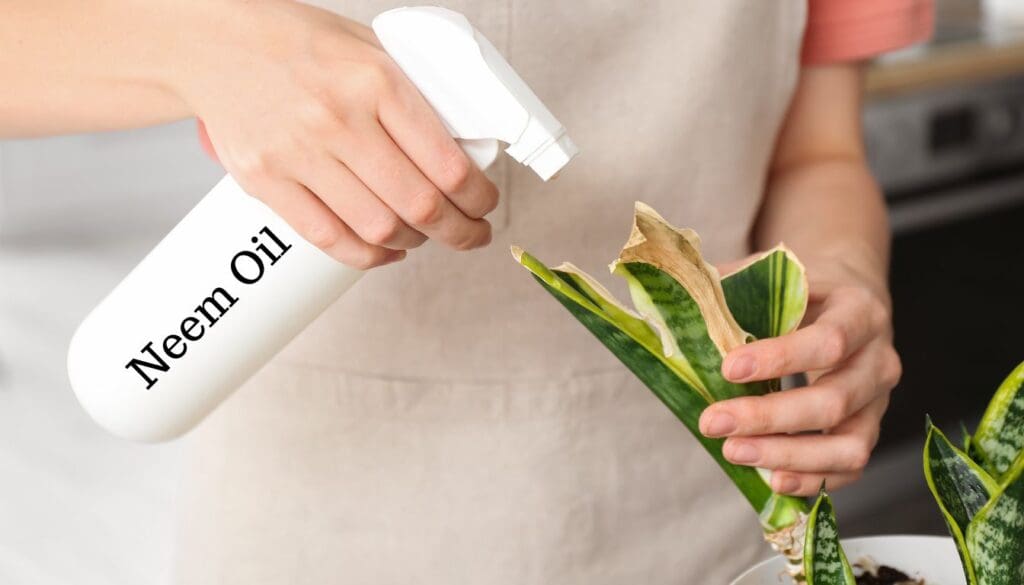
As stated above, the snake plant will develop root rot if left unattended after overwatering. If the plant has root rot, then it is challenging to avoid the pest situation.
Because of the pest situation, the snake plant can develop brown spots on the leaves.
The pests attack the newest leaves first. The leaves of the plant will turn yellow or brown.
We will also find brown spots on the leaves, and the leaves will start shedding off the plant.
Treat the pest situation, as discussed earlier in the article.
Final Words
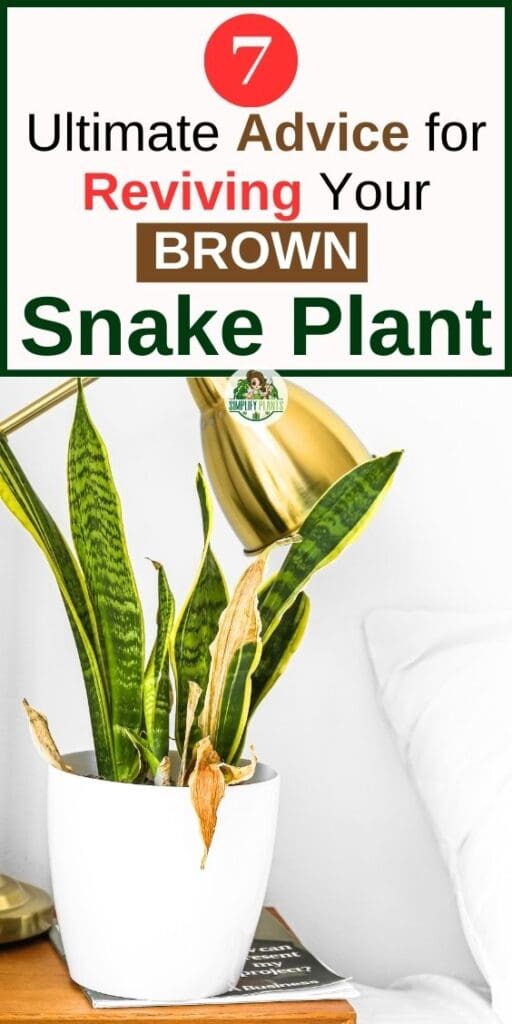
It is not difficult to care for the snake plant as they require minimal care. Just provide the snake plant with a bit of love and a few moments of your precious time.
The brown tips are a common issue, and we have listed out all the possible reasons behind the snake plant developing brown tips and brown spots on the leaves.
If there are any further issues, feel free to contact us!
Also read: Why is my snake plant dying?
Source: The University of Arkansas Division of Agriculture, University of Minnesota, Snake plant profile, Lighting Indoor Houseplants
Recommended Garden Supplies
| Product Image | Our Recommended Gardening Supplies | Check Offers! |
|---|---|---|
Top Top
Top
Top
Top
Top
Top
Top
Top | rePotme Houseplant and Tropical Classic Potting Soil Mix | Check Offer On Amazon |
 Top
Top
Top
Top
Top
Top
Top
Top | Espoma Organic Indoor Plant Food | Check Offer On Amazon |
 Top
Top
Top
Top
Top
Top
Top
Top | GooingTop LED Grow Light 6000K Full Spectrum Clip Plant Growing Lamp | Check Offer On Amazon |
 Top
Top
Top
Top
Top
Top
Top
Top | Soil Moisture Meter | Check Offer On Amazon |
 Top
Top
Top
Top
Top
Top
Top
Top | Govee Hygrometer Thermometer, Bluetooth Enabled! | Check Offer On Amazon |
 Top
Top | LEVOIT Humidifiers for Large Room(Best For Plants) | Check Offer On Amazon |
 Top
Top
Top
Top
Top
Top
Top
Top | Upgraded DIY Automatic Drip Irrigation Kit, 15 Potted Houseplants Support | Check Offer On Amazon |
 Top
Top
Top
Top
Top
Top
Top
Top | Stainless Steel Heavy Duty Gardening Tool Set | Check Offer On Amazon |
 Top
Top
Top
Top
Top
Top
Top
Top | Bonide Insecticidal Soap | Check Offer On Amazon |
 Top
Top
Top
Top
Top
Top
Top
Top | Bonide 32 oz Spray Neem Oil for Organic Gardening | Check Offer On Amazon |
 Top
Top
Top
Top
Top
Top
Top
Top | Garden Safe Fungicide | Check Offer On Amazon |


